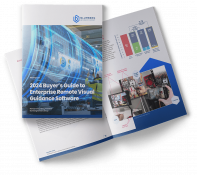Help Lightning Blog
Field Service Technology Adoption: Webinar Recap

Join John Carroll, the CEO and founder of the Service Council, for a webinar panel exploring field service technology adoption. The Service Council is a Boston-based research analyst firm. Ongoing webinar topics include service sector trends, field service survey findings, and applications of Help Lightning’s innovative technologies.
Also on the panel are Bob Lamendola of RICOH and Gary York, the CEO of Help Lightning. Michael Israel, the COO of the Service Council, also joins the discussion.
This technology adoption webinar, which is available to watch on demand, has been edited for both length and clarity.
Here’s a recap.
Macro-Trends in the Service Sector
John Carroll: Welcome! Why don’t we go ahead and kick off today’s webinar! I really appreciate everyone joining today’s discussion. We constantly see that organizations are struggling with technology adoption.
The Service Council has been following three major trends over the last twelve months, with a fourth emerging trend. The three main trends are customer transformation, service work transformation, and service worker transformation.
The emerging trend that we’ve been tracking is a reorientation of priorities for service executives. The top priorities are usually CSAT and cost. This year, however, service revenue is starting to creep up in priority.
As to customer transformation, consumerization is continuing to impact business-to-business sectors. Many large companies have digitized the customer experience. We’re expecting that in a business setting, as well.
Service work transformation can be seen in digital service delivery becoming mainstream. So the work is transforming the ways we can conduct business.
Lastly, we’re seeing changes in service workers. There is more of an extended workforce. This includes third parties, independent providers, and hybrid labor methodologies.
The Service Council has been advocating for technician agnostic and information-driven infrastructures. These allow hybrid and contract workers access to the same tools as W-2 employees.
Also, we argue that companies should use their customer experience approaches internally for employees. These are the macro-trends, but Michael Israel will discuss some of our specific survey findings.
Findings from the Field Service Engineer Survey
Michael Israel: Thank you, John. I’ll be very quick in introducing the survey. We had over 725 participants, all of whom were field service engineers (FSE’s). There are several significant results.
The majority of FSE’s see solving problems as the best part of their job. Alarmingly, 60% say they do not know if they will remain in the job for the rest of their career. This is especially true among millennials.
Most feel that IT tools make their jobs easier to perform. The vast majority prefer to call a colleague for help, rather than reach out to IT support. Six-of-ten participants feel that on-demand videos and augmented reality are useful in job performance.
While most feel that these technologies are useful, many do not have access to them. So making these tools more widely available is a potential area for growth.
RICOH as a Case Study for Field Service Technology Adoption
John Carroll: Thank you, Michael. Next Bob Lamendola will take us through a very impressive transformation that RICOH has undergone with his leadership.
Bob Lamendola: Thank you, John. RICOH is an information management and digital services company. In the past two years, we have brought our IT framework to all of our service areas. This improved our great customer relationships and also those with our employees.
One technological innovation we use is Remote Visual Assistance. This tool allows the installation process to be faster and more efficient. It leads to an increase in customer satisfaction, and it increases employee morale, as well.
When we roll out a new piece of technology, we take FSE feedback into account. We want to apply technology where it makes sense and help FSE’s through the adoption phase. These methodologies have helped with our retention levels. Our employee levels are the same as before the pandemic.
In the past year, we have expanded this framework into RICOH’s global operations. We are including multilingual options on these tools. Help Lightning has been incredibly helpful with that. They are great about listening to feedback.
We are running many different operations with this methodology. That includes mail rooms, management, training programs, and more. All of this is integrated with our IT framework for a common user experience.
Help Lightning Technology Showcase
John Carroll: Outstanding! Thank you, Bob. Gary York, the CEO of Help Lightning, will discuss the behind-the-scenes of the technology.
Gary York: Thanks, John.Help Lightning is a leading service platform that is very easy to roll out at low cost. It works on any mobile or computer device, with easy integration. We want to reduce all the friction when you are solving your customer’s problems.
Augmented reality allows an expert to be virtually present, while overcoming any linguistic barriers. Help Lightning makes it as if the expert were standing right next to the person, helping them solve the problem.

Our technologies lead to improvement in cost structure, customer satisfaction, and increases in service revenue. These are typical results for our customers that roll out these technologies. Augmented reality has been very helpful in meeting the challenges of COVID, as well.
John Carroll: Outstanding, Gary. Thank you very much.
The Value Of Field Service Technology Adoption
When a field service technician faces a difficult problem, Help Lightning’s video collaboration services can help. The wide range of remote visual assistance technologies can be integrated in both customer-facing and internal organizations.
Companies, like RICOH, have been able to streamline their customer and employee experiences using these tools. Help Lightning’s collaborative interface is compatible with tablets, computers, AR glasses, and more.
Research shows that FSR’s prefer to work with colleagues to solve difficult problems. Help Lightning’s augmented reality platform makes this easier than ever. Integrating virtual expertise into field service can improve the experiences of both employees and customers.
Request a free interactive demo of remote assistance software from Help Lightning. You can also download a RICOH case study.












